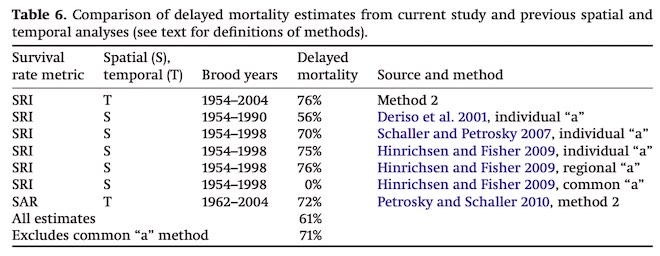forum
library
tutorial
contact

Ocean Conditions Fail to Explain
Snake River Fish Decline
by Bert Bowler
Lewiston Tribune, December 10, 2020
|
the film forum library tutorial contact |

|
Ocean Conditions Fail to Explain
by Bert Bowler
|
Snake River SARs, calculated from 1964-69, with only Ice Harbor Dam in the lower Snake,
averaged 4.3 percent for wild spring/summer chinook and 7.2 percent for wild steelhead.
 In contrast to what British Columbia scientist David Welch told the Lewiston Tribune’s Eric Barker in a Nov. 13 story: A reservoir is the antithesis of a river.
In contrast to what British Columbia scientist David Welch told the Lewiston Tribune’s Eric Barker in a Nov. 13 story: A reservoir is the antithesis of a river.
Snake River wild chinook salmon and steelhead evolved over millennia in a reservoir-free environment. The flow of water in reservoirs is significantly diminished compared with free-flowing rivers.
Data that defines the effects of dams and reservoirs on Snake River salmon and steelhead spans decades. They are consistent and very robust. A metric used to measure migration success is smolt-to-adult survival rate -- numbers of juvenile salmon entering the ocean linked to the numbers of returning adults. Snake River SARs are mostly calculated using passive integrated transponder tags that are logged at each dam.
The recent study by Welch (2020) hypothesized that if chinook populations have declined coast-wide, then declines observed in the Snake River are largely the result of shifting ocean conditions and not the river environment. SARs were estimated using recovered coded wire tags that requires killing the fish to collect and read the tag. PIT tags proffer better SAR estimates than CWT tags because they allow for multiple recaptures and don’t require killing the fish. PIT tag-based SARs are more statistically robust than CWT because researchers can define confidence intervals around their estimates. The Welch study makes no attempt to measure CIs for any SAR estimates.
The authors make an unsupportable conclusion that ocean conditions define chinook survival. The five-year time period used in the study precludes linking SARs to ocean conditions because of dispersed ocean entry points. Numerous studies describe marine survival with 300 miles of ocean entry so the influence of estuary and near-shore ocean conditions can be highly variable across such a wide geographic range of populations.
Welch used subyearling hatchery chinook as a surrogate for survival of Snake River wild yearling chinook but their freshwater life history strategies are not related.
Numerous peer-reviewed publications have described both fresh water and ocean factors best explaining the variation in yearling chinook SARs. Those studies are based on longtime series encompassing considerable variation in both marine and freshwater environments. The Welch study ignores that literature.
Welch is not convinced the region is moving in the right direction to address salmon management. "We may well be on the wrong path," he said. "Efforts to recover the fish should concentrate on the ocean and not on fresh water."
Freshwater salmon survival plummeted after completion of the federal Columbia River Hydropower System in 1975.
The most important variables affecting SARs traveling through the system are:
River flow -- the water travel time.
Spill proportion -- the route of water passage past the dams.
During the 1950s wild Idaho salmon and steelhead had unrestrained access from the upper Salmon River to the mouth of the Snake -- a distance of 600 miles. The riverine habitat for smolts and adults contributed to their reproductive success.
Snake River SARs, calculated from 1964-69, with only Ice Harbor Dam in the lower Snake, averaged 4.3 percent for wild spring/summer chinook and 7.2 percent for wild steelhead.
SARs from 1994 to 2018 averaged 0.76 percent for wild spring/summer chinook and 1.35 percent for wild steelhead. An SAR above 2 percent is required to rebuild Snake River wild populations.
Michele DeHart of the Fish Passage Center said, "Boosting survival of juvenile salmon in fresh water is critical, regardless of ocean conditions. If ocean conditions are really bad, the best response is to take steps to ensure as many juvenile fish reach the ocean in good condition as possible. The same applies when ocean conditions are good."
Related Pages:
A synthesis of the coast-wide decline in survival of West Coast Chinook Salmon by David Welch, Aswea Porter, Erin Rechisky, Fish and Fisheries, September 17, 2020
learn more on topics covered in the film
see the video
read the script
learn the songs
discussion forum
